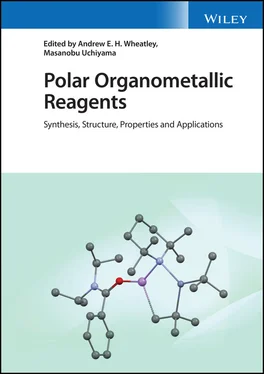Polar Organometallic Reagents
Здесь есть возможность читать онлайн «Polar Organometallic Reagents» — ознакомительный отрывок электронной книги совершенно бесплатно, а после прочтения отрывка купить полную версию. В некоторых случаях можно слушать аудио, скачать через торрент в формате fb2 и присутствует краткое содержание. Жанр: unrecognised, на английском языке. Описание произведения, (предисловие) а так же отзывы посетителей доступны на портале библиотеки ЛибКат.
- Название:Polar Organometallic Reagents
- Автор:
- Жанр:
- Год:неизвестен
- ISBN:нет данных
- Рейтинг книги:5 / 5. Голосов: 1
-
Избранное:Добавить в избранное
- Отзывы:
-
Ваша оценка:
- 100
- 1
- 2
- 3
- 4
- 5
Polar Organometallic Reagents: краткое содержание, описание и аннотация
Предлагаем к чтению аннотацию, описание, краткое содержание или предисловие (зависит от того, что написал сам автор книги «Polar Organometallic Reagents»). Если вы не нашли необходимую информацию о книге — напишите в комментариях, мы постараемся отыскать её.
Polar Organometallic Reagents
Polar Organometallic Reagents
Polar Organometallic Reagents — читать онлайн ознакомительный отрывок
Ниже представлен текст книги, разбитый по страницам. Система сохранения места последней прочитанной страницы, позволяет с удобством читать онлайн бесплатно книгу «Polar Organometallic Reagents», без необходимости каждый раз заново искать на чём Вы остановились. Поставьте закладку, и сможете в любой момент перейти на страницу, на которой закончили чтение.
Интервал:
Закладка:
6 Chapter 6Figure 6.1 Lithium amide complexes incorporating (−)‐sparteine or (+)‐sparte...Figure 6.2 Lithium enolate 9and the more complex head‐to‐head aggregated he...Scheme 6.1 Diasteromeric resolution in camphor‐derived spirocycle 11 2 ′Figure 6.3 Recently studied Evans‐type propionate enolates.Scheme 6.2 Evans enolate 12 Bn,Mehas demonstrated variable agglomeration be...Figure 6.4 Illustrative solvent‐dependent complexation of amino alkoxide 13...Figure 6.5 Recently studied products of Weinreb amide enolization.Scheme 6.3 Solvent replacement in 16 4(THF) 4through 16 4(Py) 4at −95 °C with ...Figure 6.6 Selected N,X‐lithium amides and the complex between the amide of ...Figure 6.7 Selected complexes between N,X‐ and related lithium amides and n ‐...Figure 6.8 Trinuclear 19 TIPS 2[ n ‐Bu( t ‐Bu)CHOLi].Scheme 6.4 LTMP oligomers 23 4(left) and 23 3(right) present in d 6‐benzene a...Figure 6.9 24 A–Dhave been found by a combination of PGSE and DOSY te...Scheme 6.5 Exchange rate constants (s −1) between (2‐Me 2N‐C 6H 4Li) 4 25 4, ...Scheme 6.6 35(Less water) was found to be a THF‐solvated CIP in that solven...Scheme 6.7 (i) Lithium amide‐mediated amidation and transamidation processes...Figure 6.10 Dimeric structures for 2‐MeTHF complexes of 36– 38as established...Scheme 6.8 [PhN=N(C 10H 6)O] 6Mg 2Li 2 42, based on two truncated cubes sharing a ...Scheme 6.9 The selective dimagnesiation of un‐ and monosubstituted arenes su...Scheme 6.10 Proposed equilibrium in d 12‐cyclohexane solution between sodium...Scheme 6.11 (i) Potential solution structures of 50in THF (solid‐state stru...Scheme 6.12 (i) Solution behaviour of LiCl‐free DAMgCl 57in THF, and (ii) t...Scheme 6.13 66(THF) 4has been shown to undergo dismutation in THF to give 67Scheme 6.14 The convoluted equilibrium resulting from the rearrangement of 6...Scheme 6.15 Using lithium amide 23along with 69as a TMT agent in the deriv...Figure 6.11 Colour‐coded structure of 72(left) and selected nOes associated...Scheme 6.16 The effects of order on the addition of the single‐metal compone...Scheme 6.17 Proposal for the reaction of CdCl2 with 23and a demonstration ...Scheme 6.18 Proposed solution equilibrium between CIP 79 2and its SIP form 7...Scheme 6.19 Top, reactions in Et 2O at −100 °C of RLi ( n = 2 or less, R = Me 3Scheme 6.20 Rapid injection (RI) synthesis of Cu(III) intermediate 92using ...Scheme 6.21 Synthesis of Cu(III) intermediate 95using MeCu( 13CN)Li 96.Figure 6.12 Proposed major (left) and minor (right) π‐complexes achieved by ...Figure 6.13 In 100, Sol = d 10‐OEt 2, which gradually changes to d 8‐THF as m...Scheme 6.22 The structural possibilities elucidated for cuprate 102in hydro...Scheme 6.23 The effect of gradual THF addition to a hydrocarbon solution of Scheme 6.24 Synthesis of 109and the 7Li NMR spectrum obtained upon dissolvi...Figure 6.14 Depending on their relative populations, heating LTMP 23and CuT...Scheme 6.25 Synthesis of 112– 114via intermediate 116.Scheme 6.26 Dissociative interchange of Li and TMP in 114, mediated by symme...Scheme 6.27 Proposed two‐step mechanism for AMM Zn , in this case of anisole, ...Scheme 6.28 The contrasting reactivities of 118and 119towards HTMP in d 6Scheme 6.29 Contrasting outcomes of the AMM Zn of fluoromethylbenzene by sodi...Scheme 6.30 Proposed mechanism (from DFT calculations) for the directed meta...Scheme 6.31 Synthesis of heteroleptic, alkoxide‐containing lithium zincates Scheme 6.32 Concentration‐dependent, dynamic equilibrium of 133with its mon...Scheme 6.33 A temperature‐dependent equilibrium process affecting 135in THF...
7 Chapter 7Scheme 7.1 Reports of nucleophilic boron compounds prior to boryllithium [Di...Scheme 7.2 Synthesis of boryllithium 4and its reaction with water.Figure 7.1 Crystal structures of ( 4·DME) 2and 4·(THF) 2.Scheme 7.3 Reactivity of boryllithium 4as a boron nucleophile.Scheme 7.4 (a) Generation of boryl anion 8as an ate complex of lithium in a...Figure 7.2 Crystal structure of 8.Scheme 7.5 Synthesis and reactivity of 1,2,4,3‐triazaborol‐3‐yllithium 9.Scheme 7.6 Synthesis and reactivity of NHC‐stabilized borole anion 10(Mes =...Scheme 7.7 Synthesis and reactivity of NHC‐stabilized parent boryl anion 11....Scheme 7.8 Synthesis and reactivity of cAAC‐stabilized parent boryl anion 12Scheme 7.9 Synthesis and reactivity of cyanide‐stabilized λ 3‐tricyanob...Scheme 7.10 Synthesis and reactivity of cAAC‐stabilized dicyanoboryl anion 1...Scheme 7.11 Synthesis and reactivity of NHC‐stabilized dicyanoboryl anion 15Scheme 7.12 Linear dimetalloborylene complex 16having a nucleophilicity on ...Scheme 7.13 Synthesis and reactivity of borylmagnesium.Scheme 7.14 Generation of borylcopper and borylzinc species from boryllithiu...Scheme 7.15 Generation of borylmagnesium and borylzinc species 9from 1,2,4,...Scheme 7.16 Generation of borylzinc species from boryllithium 21and subsequ...Scheme 7.17 Nucleophilic borylation of boron compounds by using boryllithium...Scheme 7.18 Reaction of boryllithium 4with amino(dibromo)pnictogen [Ar = 2,...Scheme 7.19 Generation of borylmagnesium species by transmetalation of B 2pinScheme 7.20 Reactivity of 41and 42.Scheme 7.21 Zinc‐catalyzed borylation of aryl halide involving borylzincate Scheme 7.22 Generation of boryl(cyano)cuprate 52and subsequent reaction wit...Scheme 7.23 Direct carboboration of 1‐phenylpropyne derivatives by using bor...Scheme 7.24 Pd‐catalyzed coupling of borylzinc 58with bromoarenes and acid ...
8 Chapter 8Figure 8.1 Zinc ate complexes.Scheme 8.1 Halogen–zinc exchange reaction of aryl iodides with Li[ZnMe 3].Scheme 8.2 Enhanced reactivity of di‐anion‐type zincate.Scheme 8.3 Li 2[Zn t ‐Bu 4]: proton‐proof metalating agent.Scheme 8.4 Negishi‐type cross‐coupling reaction via C–O bond cleavage.Figure 8.2 Heteroleptic zincates: an enormous range of possibilities.Scheme 8.5 Highly regio‐ and chemoselective zincation of (hetero)aromatics....Scheme 8.6 Ortho ‐iodination of bromobenzenes without benzyne formation.Scheme 8.7 Chemoselective deprotonative ortho ‐alumination with Li[(TMP)Al i ‐B...Scheme 8.8 Directed ortho ‐cupration with Li 2[(TMP)Cu(CN)Me].Scheme 8.9 Arylcuprate reactivity.Scheme 8.10 Amidocuprate hydroxylation of aromatics.Scheme 8.11 DFT calculations (kcal/mol) to assess the reaction mechanism for...Scheme 8.12 Amidocuprate amination of aromatics.Scheme 8.13 Reduction of carbonyl compounds with M[HZnMe 2].Scheme 8.14 Semi‐reduction of carboxylic acids to aldehydes.Scheme 8.15 Direct conversion of carboxylic acids to ketones by zincates.Scheme 8.16 Silylzincation of alkynes with SiBNOL‐Zn‐ate.Scheme 8.17 Silylzincation of alkynes via Si–B bond activation.Scheme 8.18 Silylzincation of alkenes with SiSiNOL‐Zn‐ate catalyzed by Cp 2Ti...Scheme 8.19 CuCN‐catalyzed silylzincation of alkenes.Figure 8.3 Decomposition of R F‐organometallics.Scheme 8.20 Zincation of perfluoroalkyl iodide.Scheme 8.21 Perfluoroalkylation and ‐arylation of carbonyl compounds.Scheme 8.22 Aromatic perfluoroalkylation.Figure 8.4 Model DFT calculation on borylzincate formation M06/SVP (Zn) and ...Figure 8.5 Design of a catalytic boration cycle for aryl halides.Scheme 8.23 Substrate scope of aromatic boration.Scheme 8.24 Borylzincation reaction of benzynes.Figure 8.6 Concept for the trans ‐selective boration of triple bonds.Scheme 8.25 Fruitless intermolecular diboration of alkynes.Scheme 8.26 Trans ‐selective diboration of alkynes.Scheme 8.27 One‐pot diboration reactions.Scheme 8.28 Sequential diboration/Suzuki–Miyaura cross‐coupling, leading to ...Scheme 8.29 Trans ‐alkynylboration of alkynes.Scheme 8.30 Transformation of oxaboroles.
Читать дальшеИнтервал:
Закладка:
Похожие книги на «Polar Organometallic Reagents»
Представляем Вашему вниманию похожие книги на «Polar Organometallic Reagents» списком для выбора. Мы отобрали схожую по названию и смыслу литературу в надежде предоставить читателям больше вариантов отыскать новые, интересные, ещё непрочитанные произведения.
Обсуждение, отзывы о книге «Polar Organometallic Reagents» и просто собственные мнения читателей. Оставьте ваши комментарии, напишите, что Вы думаете о произведении, его смысле или главных героях. Укажите что конкретно понравилось, а что нет, и почему Вы так считаете.












